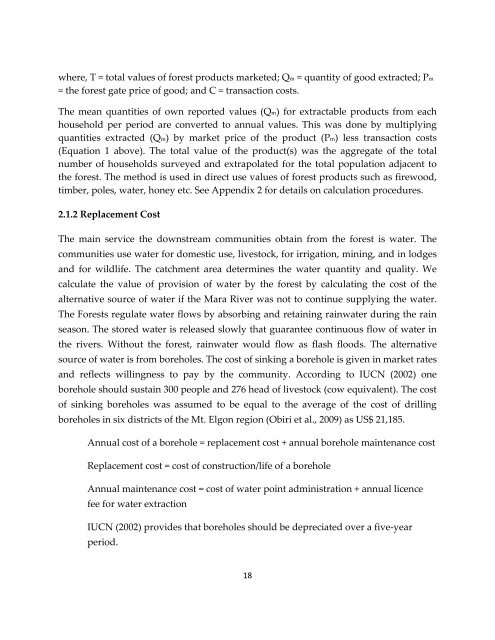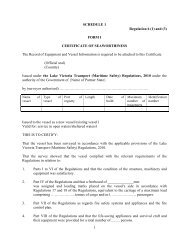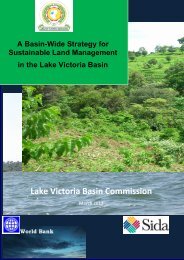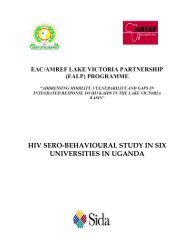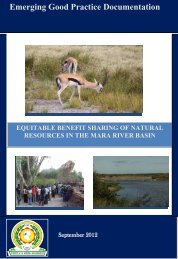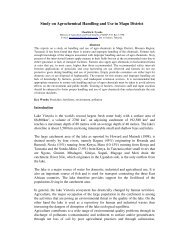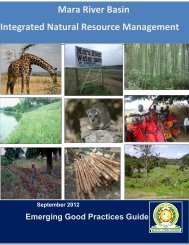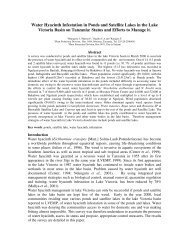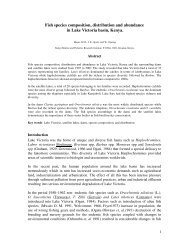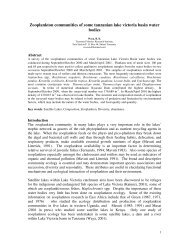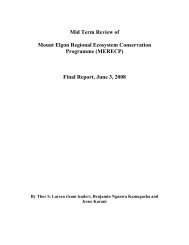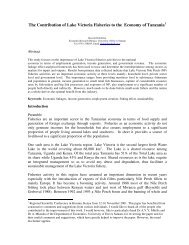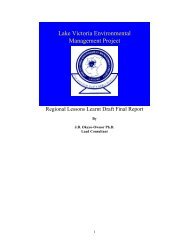Total Economic Value of Maasai Mau, Trans Mara and Eastern Mau ...
Total Economic Value of Maasai Mau, Trans Mara and Eastern Mau ...
Total Economic Value of Maasai Mau, Trans Mara and Eastern Mau ...
Create successful ePaper yourself
Turn your PDF publications into a flip-book with our unique Google optimized e-Paper software.
where, T = total values <strong>of</strong> forest products marketed; Qm = quantity <strong>of</strong> good extracted; Pm= the forest gate price <strong>of</strong> good; <strong>and</strong> C = transaction costs.The mean quantities <strong>of</strong> own reported values (Qm) for extractable products from eachhousehold per period are converted to annual values. This was done by multiplyingquantities extracted (Qm) by market price <strong>of</strong> the product (Pm) less transaction costs(Equation 1 above). The total value <strong>of</strong> the product(s) was the aggregate <strong>of</strong> the totalnumber <strong>of</strong> households surveyed <strong>and</strong> extrapolated for the total population adjacent tothe forest. The method is used in direct use values <strong>of</strong> forest products such as firewood,timber, poles, water, honey etc. See Appendix 2 for details on calculation procedures.2.1.2 Replacement CostThe main service the downstream communities obtain from the forest is water. Thecommunities use water for domestic use, livestock, for irrigation, mining, <strong>and</strong> in lodges<strong>and</strong> for wildlife. The catchment area determines the water quantity <strong>and</strong> quality. Wecalculate the value <strong>of</strong> provision <strong>of</strong> water by the forest by calculating the cost <strong>of</strong> thealternative source <strong>of</strong> water if the <strong>Mara</strong> River was not to continue supplying the water.The Forests regulate water flows by absorbing <strong>and</strong> retaining rainwater during the rainseason. The stored water is released slowly that guarantee continuous flow <strong>of</strong> water inthe rivers. Without the forest, rainwater would flow as flash floods. The alternativesource <strong>of</strong> water is from boreholes. The cost <strong>of</strong> sinking a borehole is given in market rates<strong>and</strong> reflects willingness to pay by the community. According to IUCN (2002) oneborehole should sustain 300 people <strong>and</strong> 276 head <strong>of</strong> livestock (cow equivalent). The cost<strong>of</strong> sinking boreholes was assumed to be equal to the average <strong>of</strong> the cost <strong>of</strong> drillingboreholes in six districts <strong>of</strong> the Mt. Elgon region (Obiri et al., 2009) as US$ 21,185.Annual cost <strong>of</strong> a borehole = replacement cost + annual borehole maintenance costReplacement cost = cost <strong>of</strong> construction/life <strong>of</strong> a boreholeAnnual maintenance cost = cost <strong>of</strong> water point administration + annual licencefee for water extractionIUCN (2002) provides that boreholes should be depreciated over a five-yearperiod.18


